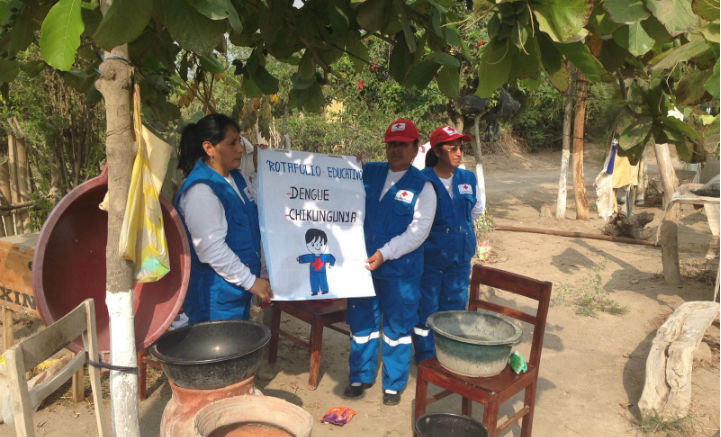Forecast Based Financing
When a natural disaster strikes, it often has enormous and devastating consequences for the most vulnerable parts of the population. To reduce the impacts of disasters, scientific forecasts can be a useful tool to prepare communities for what is coming. However, the problem has often been that although forecasts are available, it has not been possible to use them to effectively prepare humanitarian resources and take action, due to a lack of funding prior to the disaster.
Being able to make use of the early warnings would mean saving lives and homes in a cost-effective manner. There are many actions that can be taken in the window between a forecast and a disaster, which can make the disaster much less devastating for communities in vulnerable areas.
Aiming to address this issue, the German Red Cross and its partners, including the German Federal Foreign Office, the Red Cross Red Crescent Climate Centre (RCCC), and the World Food Program (WFP), have developed a framework for Forecast-based financing (FbF). FbF is a strategy to enable anticipatory humanitarian action by releasing a pool of funds triggered by scientific forecasts of extreme weather events, such as droughts or floods. This approach makes it possible to act before the disaster strikes, and thus avoid suffering and losses by reducing risks and strengthening the resilience of the vulnerable communities.
The FbF framework has developed new processes to prepare, deliver and respond in a more effective manner based on national and international hydro-meteorological forecasts. It identifies danger levels and early actions. These pre-defined actions are triggered when a forecast exceeds a danger level in a vulnerable intervention area, for example, an amount of rain that causes the flooding of rivers.
The key aspects of FbF are:
- Understanding risk scenarios by including historical impact data and level of vulnerability.
- Identifying available forecasts, and using national and international data.
- Formulating early actions, such as awareness raising, or strengthening houses.
- Identifying danger levels.
- Creating a Standard Operating Procedure (SOP), which includes the trigger, the pre-defined early actions, responsibilities, when to act, where to act and the funds to make available.
- Validating the SOP with key actors.
- Monitoring hydro meteorological forecasts and assessing whether the danger level is exceeded, in which case early actions should be implemented according to the SOP.
With the support of the German Federal Foreign Office, the German Red Cross has started testing FbF in several pilot projects, using flexible preparedness funds to implement the actions specified in the SOPs once triggers have been reached. All projects are being continuously assessed and scientifically evaluated. For example, with regards to the impact of the early actions in terms of reducing the humanitarian consequences of extreme weather events, the precision of the forecasts used, how the approach can be improved, or the costs and benefits of various actions.

In addition, the FbF approach is currently being tested operationally by the Red Cross Red Crescent Movement in several countries. One of the cases where FbF was applied was in 2015-2016 during El Niño - an oscillation of the ocean-atmosphere system in the tropical Pacific which has important consequences for weather around the globe. In Peru, past El Niño-related events have had a large impact on health, drinking water, food security and housing. The country has particularly suffered from strong rains, river flooding and severe droughts.
By making use of FbF it was possible to take early actions and ensure communities were ready for an expected strong El Niño phenomenum in 2015-2016. It was ensured that basic needs, such as for hygiene and drinking water, would be met at the time that families and communities needed them the most. The Red Cross carried out activities in the fields of community based early warning, first aid, safe drinking water, heath and hygiene and the strengthening and protection of houses.
Although, the scientific signals that are used to predict the strength of an El Niño event have improved, the local and international communities still face challenges to predict where El Niño will occur, and how it will influence local weather patterns. This means that some of the actions during El Niño in 2015-2016 did not have an immediate impact, as communities did not experience the strong rains that had been anticipated. Nevertheless, the actions were of great value for the population in the long run. By contributing to building the early action and preparedness capacity of the Peruvian Red Cross and local communities, for example by improving the stability of houses, making water purification tablets available at household level, and raising awareness of the risks in vulnerable rural areas, the project had long-term benefits that strengthened resilience for future events. This was shown during the coastal El Nino in 2016-17, when the communities that had been involved in the project were less affected than in past El Nino events.
The first lessons learned of the FbF projects and new research carried out by the WFP show that this method can not only save human lives, but can also can save critical resources – making it possible to stretch humanitarian aid further and help more people globally.
Basic information
Activity name
Forecast-based financing (FbF)
Country
Peru
Duration
2015
Partners
German Red Cross, German Federal Foreign Office, Red Cross Red Crescent Climate Centre (RCCC), World Food Program (WFP)
For more information on FbF, visit the Red Cross Red Crescent Climate Centre’s website.

